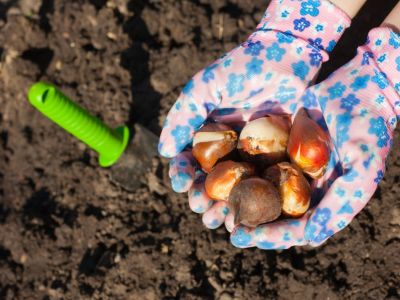Flower Garden Bulbs
Flower garden bulbs are available in so many types that it’s not hard to find one that fits your region and gardening style, which is especially important when growing them in the south. The health, vigor, and flowering of bulbs depend greatly on where, when, and how you plant them. Both winter garden bulbs and spring bulbs require a dormant period in cool temperatures to stimulate their growth and development. Since southern states typically have mild winters, it’s important that these bulbs be pre-chilled prior to planting. You can purchase pre-chilled bulbs or chill them yourself in dry, cold storage of 40 to 45 degrees F. (4-7 C.) for at least 12 weeks using a suitable cold frame, unheated basement, or refrigerator (without vegetables). Tender bulbs, on the other hand, which bloom throughout summer and fall, are extremely sensitive to cold conditions and thrive in the southern climates.
When to Plant Bulbs in the South
When deciding when to plant bulbs in the south, always check a bulb’s growing requirements beforehand to ensure proper planting. Bulbs should typically be planted as soon as possible to prevent them from drying. Winter garden bulbs and hardy spring-flowering bulbs (tulips, crocuses, daffodils, and hyacinths) are planted in the fall. While northern states typically plant their hardy bulbs in September or October, here in the south, planting can be extended well into November and even December. Tender flower garden bulbs (elephant ears, caladiums, gladioli, cannas, and dahlias) are planted in the spring once the threat of cold has ceased, and the ground has significantly warmed up.
How to Plant Bulbs in the South
Knowing how to plant bulbs in the south is as important as when to plant bulbs in the south. Most flower garden bulbs require well-drained soil to prevent them from rotting. To improve the quality of your soil, you can work in some sand and compost. Depending on the variety, most bulbs are planted in a sunny location of the garden while others can tolerate lightly shaded conditions. Once again, checking the growing requirements is crucial. Always place bulbs with the points facing upward. Corms should be placed with the depression facing upward, while tubers and rhizomes lie sideways with eyelets facing up. These types are generally placed just at the soil’s surface while other bulbs depend on their size, usually half as deep as their height. Cover with a layer of mulch and water thoroughly after planting.
Winterizing Garden Bulbs
Tender bulbs are unable to survive cold winters and require lifting in the fall for winter storage in a cool, dark place. In the south, however, temperatures are usually mild enough during winter, so winterizing garden bulbs isn’t necessary. They can remain in ground throughout winter without any harm. While hardy bulbs can also remain in ground, you may want to lift them for chilling, or simply purchase new ones.
